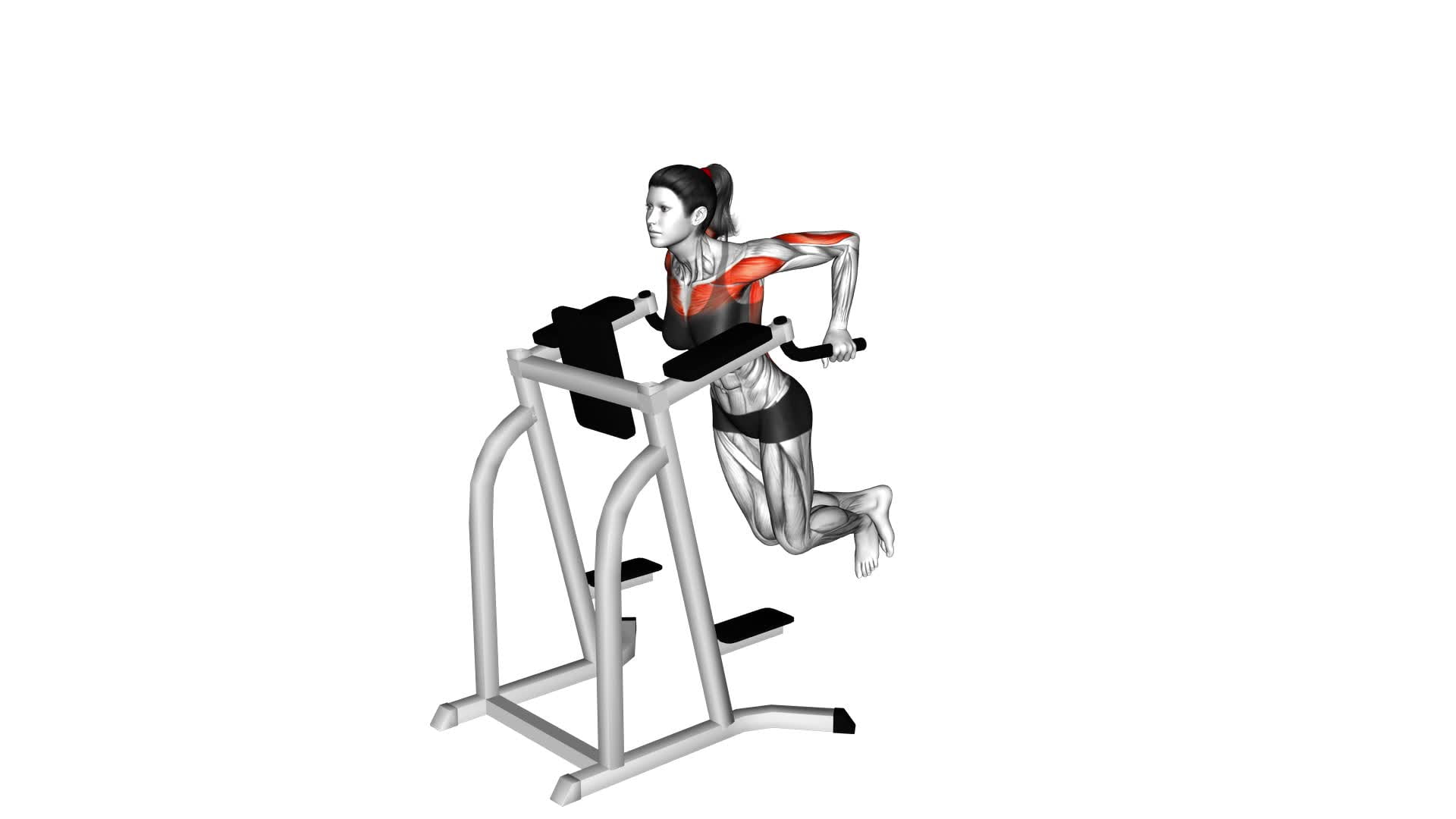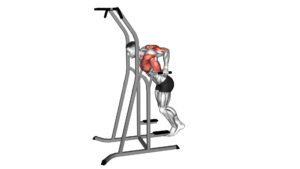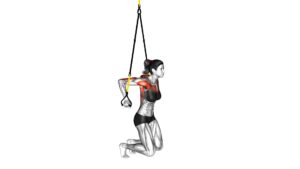Chest Dip (female) – Video Exercise Guide & Tips

Are you looking to tone and strengthen your chest muscles? Look no further than the chest dip exercise!
Watch This Exercise Video
In this video exercise guide, we'll show you the proper form and technique for performing chest dips, along with essential equipment and setup.
Avoid common mistakes and maximize your results with our helpful tips.
Get ready to take your chest workout to the next level with this informative and instructional video guide.
Let's get started!
Key Takeaways
- Chest dips target and strengthen the chest muscles.
- Chest dips engage multiple muscle groups.
- Chest dips improve upper body strength.
- Chest dips enhance posture and help develop a toned and sculpted chest.
Benefits of Chest Dips for Females
Experience the numerous benefits of chest dips for females, as this exercise effectively targets and strengthens your chest muscles. Chest dips are a compound exercise that engage multiple muscle groups, including the pectoralis major, triceps, and deltoids. By performing chest dips regularly, you can improve your upper body strength, enhance your posture, and develop a toned and sculpted chest.
One of the advantages of chest dips is that they can be modified to suit your fitness level and goals. If you're a beginner, you can start with assisted chest dips using a resistance band or a dip machine. This allows you to gradually build strength and stability before progressing to unassisted dips. On the other hand, if you're looking for a challenge, you can add weights or use a weighted dip belt to increase the resistance and intensify the exercise.
In addition to chest dips, there are alternative exercises that can also target your chest muscles. Push-ups are a great alternative and can be easily modified by adjusting the hand position or elevating your feet. Other alternatives include chest presses using dumbbells or a barbell, and chest fly exercises using cables or dumbbells.
Proper Form and Technique for Chest Dips
To perform chest dips with proper form and technique, you need to focus on engaging your chest muscles while maintaining stability throughout the exercise. This will ensure that you're effectively targeting your chest and minimizing the risk of injury.
When performing chest dips, start by gripping the parallel bars firmly with your palms facing down. Keep your elbows slightly bent and your shoulders back and down. Lower your body by bending your elbows until your chest is parallel or slightly below the bars. Pause for a moment, then push through your palms and straighten your arms to return to the starting position.
It is important to maintain control throughout the movement and avoid swinging or using momentum to complete the exercise. Engage your chest muscles by squeezing them as you push yourself back up.
If you find chest dips too challenging or need some modifications, you can try using an assisted dip machine or resistance bands to help support your body weight. Alternatively, push-ups and chest presses can be great alternative exercises for chest development.
Remember to always listen to your body and adjust the exercise to your fitness level. Proper form and technique are crucial for maximizing the benefits of chest dips and preventing injuries.
Essential Equipment and Setup for Chest Dips
For proper execution of chest dips, you'll need to set up the essential equipment and adjust it to your desired position. Here are the necessary steps to set up the equipment for chest dips:
- Find a dip station or parallel bars: Look for a sturdy dip station or parallel bars that can support your body weight. Make sure it's at a comfortable height for you to grip and lower yourself.
- Adjust the width: Position your hands shoulder-width apart on the bars. This will target your chest muscles effectively during the exercise.
- Secure your grip: Hold onto the bars firmly with your palms facing down. Make sure your grip is strong and stable before you begin.
- Position your body: Stand between the bars and lift yourself up, taking your body weight onto your arms. Keep your elbows slightly bent and your chest lifted. This is your starting position for chest dips.
Common Mistakes to Avoid During Chest Dips
When performing chest dips, it's important to be aware of common mistakes that can hinder your progress and potentially lead to injuries.
One common mistake to avoid is incorrect hand placement, as placing your hands too wide or too close together can put unnecessary strain on your shoulders and wrists.
Additionally, make sure to maintain proper form throughout the exercise, avoiding swinging or using momentum to lift your body.
Lastly, be cautious not to overexert yourself, as pushing beyond your limits can increase the risk of injury.
Incorrect Hand Placement
Make sure you place your hands at shoulder-width apart to avoid incorrect hand placement during chest dips.
Incorrect hand placement during chest dips can lead to improper form and potential injury. To ensure proper hand positioning and shoulder alignment, follow these tips:
- Place your hands on the parallel bars, with your palms facing down and fingers pointing forward.
- Position your hands shoulder-width apart, ensuring that your elbows are slightly bent.
- Keep your shoulders down and back, engaging your chest and core muscles.
- Maintain a neutral wrist position, avoiding excessive bending or arching.
By placing your hands at the correct width and maintaining proper alignment, you can maximize the effectiveness of your chest dips while minimizing the risk of injury.
Now, let's move on to the next section and discuss the importance of maintaining proper form during this exercise.
Lack of Proper Form
To ensure proper form and avoid common mistakes during chest dips, focus on maintaining correct hand placement and alignment as discussed in the previous subtopic.
In addition to hand placement, it's important to be mindful of other factors that can contribute to a lack of proper form. One common mistake to avoid is swinging your body excessively during the exercise. This not only decreases the effectiveness of the chest dip but also puts unnecessary strain on your shoulders.
Another mistake to avoid isn't lowering yourself enough during the dip, which can limit the range of motion and the activation of your chest muscles.
Lastly, always remember to engage your core and keep your body straight throughout the movement.
By following these tips, you can prevent shoulder injuries and maximize the benefits of chest dips.
If you find chest dips too challenging or you're looking for alternative exercises, consider trying push-ups or bench presses, which target the chest muscles in a similar way.
Overexertion and Injuries
To prevent overexertion and avoid injuries during chest dips, focus on maintaining proper form and avoiding common mistakes discussed in the previous subtopic.
Here are some key tips to help you prevent injuries and recover effectively:
- Listen to your body: Pay attention to any pain or discomfort during the exercise. If something doesn't feel right, stop and reassess your form.
- Start slowly and progress gradually: Don't push yourself too hard too soon. Start with easier variations and gradually increase the difficulty level as your strength improves.
- Warm up and cool down: Before starting your chest dip workout, warm up your muscles with dynamic stretches. Afterward, cool down with static stretches to promote recovery.
- Incorporate recovery strategies: Give your body enough time to recover between chest dip sessions. This includes getting enough sleep, staying hydrated, and nourishing your body with proper nutrition.
By following these injury prevention and recovery strategies, you can safely engage in chest dips and minimize the risk of overexertion and injury.
Now, let's move on to the next section to learn some tips to maximize your results with chest dips.
Tips to Maximize Your Results With Chest Dips
To maximize your results with chest dips, focus on proper form and technique. Chest dips are a great exercise for maximizing upper body strength and incorporating them into your workout routine can help you achieve your fitness goals more effectively. Here are some tips to help you get the most out of your chest dips.
Firstly, ensure that your grip is firm and your elbows are slightly bent. This will engage your chest muscles and prevent unnecessary strain on your shoulders. As you lower yourself, make sure to keep your core tight and your chest lifted. This will help you maintain stability and target the right muscles.
Secondly, control your descent and ascent. Avoid using momentum to go up and down as this reduces the effectiveness of the exercise. Instead, focus on slow and controlled movements. This will engage your muscles throughout the entire range of motion and maximize your gains.
Lastly, don't forget to breathe properly. Inhale as you lower yourself and exhale as you push yourself back up. This will help you maintain a steady rhythm and ensure that you're getting enough oxygen to your muscles.
Variations and Progressions for Chest Dips
For even more challenging workouts, try incorporating variations and progressions into your chest dips routine. By adding these advanced chest dip variations and progressions, you can continue to challenge your muscles and make further progress in your fitness journey.
Here are four variations and progressions to take your chest dips to the next level:
- Weighted Chest Dips: Attach a weight plate or wear a weighted vest to add resistance to your chest dips. This will increase the intensity and help you build more strength in your chest, shoulders, and triceps.
- Single Leg Chest Dips: Lift one leg off the ground and perform chest dips with the other leg. This variation engages your core and stabilizer muscles more, making it a great way to further develop your overall strength and balance.
- Plyometric Chest Dips: Incorporate explosive movements into your chest dips by pushing off the bars with enough force to allow your hands to leave the bars momentarily. This plyometric variation helps improve explosive power and can enhance your athletic performance.
- Ring Chest Dips: Use gymnastic rings instead of parallel bars for your chest dips. This challenges your stability and activates additional muscles in your upper body, providing a unique and effective variation.
Incorporating these chest dip variations and advanced progressions into your routine will help you continue to push your limits and achieve new levels of strength and fitness. Remember to start with proper form and gradually increase the difficulty as you progress.
Frequently Asked Questions
Can Chest Dips Help in Toning the Upper Body Muscles Other Than the Chest?
Chest dips, especially for females, are effective muscle toning exercises that target not only the chest but also the upper body muscles. By incorporating chest dips into your workout routine, you can strengthen and tone your triceps, shoulders, and back muscles.
This exercise helps in building upper body strength and creating a well-rounded physique. To maximize the benefits, ensure proper form and gradually increase the intensity and repetitions of your chest dips.
Are Chest Dips Suitable for Beginners or Should They Be Performed Only by Advanced Athletes?
Chest dips can be a great exercise for beginners to build upper body strength. They can also benefit women by toning their chest, shoulders, and triceps.
To modify for beginners, start with assisted dips using a resistance band or bench. As you progress, you can increase the difficulty by using your body weight or adding weights.
Always focus on maintaining proper form and start with a comfortable number of repetitions.
Can Chest Dips Be Performed at Home Without Any Equipment?
Yes, chest dips can be performed at home without any equipment. If you don't have dip bars, you can try chest dip alternatives like using chairs or parallel bars.
Chest dips are a great exercise for targeting your chest muscles and building upper body strength. They also engage your triceps and shoulders, providing a comprehensive workout.
Remember to maintain proper form, keeping your core engaged and elbows tucked in, for maximum benefits.
How Frequently Should Chest Dips Be Incorporated Into a Workout Routine for Optimal Results?
To achieve optimal results, it's important to incorporate chest dips into your workout routine with the right frequency.
The frequency will depend on your fitness level and goals. For muscle toning, aim to perform chest dips at least 2-3 times per week. However, be sure to give your muscles enough rest and recovery time in between sessions.
Additionally, try different variations of chest dips, such as using a weighted vest or performing inclined or declined dips, to target different muscles and challenge yourself further.
Are There Any Specific Precautions or Modifications That Should Be Considered for Individuals With Shoulder or Wrist Injuries When Performing Chest Dips?
When performing chest dips, it's important to take precautions if you have shoulder or wrist injuries.
To protect your shoulders, start with a proper warm-up to increase blood flow and flexibility. Avoid going too deep in the dip to prevent excessive strain on your shoulders.
For wrist injuries, try using wrist wraps or modify the exercise by using parallel bars or dip machines that provide better wrist support.
Always listen to your body and consult a professional if needed.
Conclusion
In conclusion, chest dips are a highly beneficial exercise for females looking to strengthen and tone their upper body. By maintaining proper form and technique, using the necessary equipment and avoiding common mistakes, you can maximize your results with chest dips.
Additionally, incorporating variations and progressions into your routine can help challenge your muscles and continue to see progress.
So, grab a dip bar and start incorporating chest dips into your workout routine for stronger and defined chest muscles.

Author
Years ago, the spark of my life’s passion ignited in my mind the moment I stepped into the local gym for the first time. The inaugural bead of perspiration, the initial endeavor, the very first surge of endorphins, and a sense of pride that washed over me post-workout marked the beginning of my deep-seated interest in strength sports, fitness, and sports nutrition. This very curiosity blossomed rapidly into a profound fascination, propelling me to earn a Master’s degree in Physical Education from the Academy of Physical Education in Krakow, followed by a Sports Manager diploma from the Jagiellonian University. My journey of growth led me to gain more specialized qualifications, such as being a certified personal trainer with a focus on sports dietetics, a lifeguard, and an instructor for wellness and corrective gymnastics. Theoretical knowledge paired seamlessly with practical experience, reinforcing my belief that the transformation of individuals under my guidance was also a reflection of my personal growth. This belief holds true even today. Each day, I strive to push the boundaries and explore new realms. These realms gently elevate me to greater heights. The unique combination of passion for my field and the continuous quest for growth fuels my drive to break new ground.



